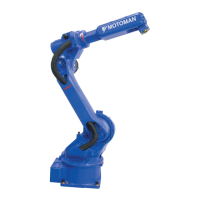5-9
168542-1CD
168542-1CD
MLX200 Software and
Operations
5 Collision Detection
5.3 Using the MLxRobotCollisionDetection Instruction
5.3 Using the MLxRobotCollisionDetection Instruction
The previous section described how to configure Collision Detection from
the MLX HMI, and this is the recommended method for initially configuring
Collision Detection. However, after initial configuration, it is useful to
change Collision Detection behavior from the application code itself. This
can be useful for properly initializing Collision Detection during application
setup or for changing the Collision Detection behavior at different points in
the operation of the program (for example, to have stricter behavior at
pick/place operations to prevent product damage). This can be done by
using the MLxRobotCollisionDetection instruction (Fig. 5-9)..
Fig. 5-9: MLxRobotCollisionDetection Instruction
This instruction operates much like other configuration instructions in that
the instruction will be complete when the Sts_DN bit is turned on. Table
5-1 shows the parameters of this instruction and their meanings.
Table 5-1: MLxRobotCollisionDetection Instruction Parameters
Parameter Description
RobotNumber The robot commanded by this instruction instance. Valid
values are 0 to MLX[].NumberOfRobots-1.
CollisionFile The Collision File to use. Valid values are 0 to
ApplicationData.NumberOfCollisionFiles-1
Action Use this to define the action taken by the instruction. Valid
actions are:
0 - Start Measurement Mode.
1 - Start Execution Mode.
2 - Stop Collision Monitoring.
3 - Get Maximum Torque Disturbance.
4 - Reset Maximum Torque Disturbance.
ApplicationData The MLXApplicationData controller scope tag.

